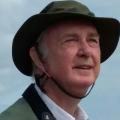
Wild Things columnist Eric Brown says the goggle box in the corner of the room can cause family strife but may also be a significant force for good with Sir David Attenborough’s new series set to highlight conservation issues.
Television must spawn more arguments in the home than any other subject as families squabble over the remote to select favourite programmes or switch off dross.
In my case the totally missmable includes Top Gear, Love Island, anything featuring Ant and Dec, Eastenders, The Wheel, Casualty, baking competitions and anything showing people I've never heard of eating insects in the jungle.
And I'm only just getting started.
Wild Things: Action is needed now
But similarly television can send unforgettable images to our living rooms with positive consequences. Who can forget the horror of seeing a little girl running towards camera screaming in terror with her naked body on fire after being caught in a US air raid on her village in Vietnam? Who could fail to be moved by grim pictures of starving children in Africa or the aftermath of recent earthquakes in Turkey. The first example spawned a backlash against American napalm bombing while the second led a number of pop stars to raise money devising Transatlantic concerts and the best-selling single record of all time. Cash is still pouring in for homeless Turkish earthquake victims.
Yes television has come a long way since plummy-voiced newsreaders wearing dinner jackets and bow ties read bulletins from Alexandra Palace and children's favourites like Muffin the Mule and Bill and Ben gambolled across flickering black and white screens with their puppet strings clearly visible.
Nowhere has this been more evident than in wildlife series. Early film of wild animals and birds had to be shot from distance with primitive camera lenses. Now, due to technical advances, we can see what is happening under the oceans, down puffin or rabbit burrows or inside a badger sett. Mechanical cranes allow presenters to be winched aloft to show viewers birds of prey tenderly feeding young high in swaying pine tree nests.
A rather excellent Channel Five series called Secret Life of the Forest is being screened at eight pm on Wednesdays just now. Mainly focused on the introduction of beavers to Yorkshire forests, it also featured items on deer, nightjars, turtle doves and goshawks. I learned that chaffinches have 10 different songs.
But the series will surely be eclipsed by Sir David Attenborough's latest BBC offering. The man who gave us Blue Planet, Planet Earth and other wildlife delights temporarily abandoned globetrotting to create a series about British wildlife.
Wild Things: It's time for birds to go courting
This is the realisation of a dream for Sir David, 96, who has filmed in every corner of the globe while neglecting his own country. In the five-part Wild Isles he puts this right by seeking out wildlife from the Scillies to the Shetlands. Few content details have been released but I have established one sequence will show peregrine falcons attacking knots and another captures leeches attacking toads. According to producer Alastair Fothergill: "Britain has 22,000 miles of coastline, more ancient oaks than the rest of Europe, half the world's common bluebells, a quarter of the badgers and 80 per cent of the world's chalk streams. But we are in real danger of losing it all." So expect a pretty heavy conservation message from Sir David with some memorable images designed to prompt action.
Wild Isles has not been allocated a time slot as I write but is expected to be screened in March or April. Don't miss it.



Comments: Our rules
We want our comments to be a lively and valuable part of our community - a place where readers can debate and engage with the most important local issues. The ability to comment on our stories is a privilege, not a right, however, and that privilege may be withdrawn if it is abused or misused.
Please report any comments that break our rules.
Read the rules here